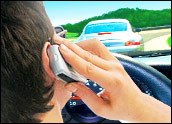
It wasn’t all that long ago that the talk about cellphones and driving was all talk. That is, consumers, driving-safety advocates, and lawmakers debated whether using a hands-free device was enough to make talking on a cellphone safe, or whether talking on the newly ubiquitous devices while behind the wheel should be banned outright.
However, the startling growth of text messaging — from 14.4 million in December of 2000 to 110.4 billion last December, or about 1 trillion for all of 2008, according to CTIA, The Wireless Association — and a rash of texting-related accidents have helped put the focus squarely on the tiny keyboards of modern mobile phones. [*Correction – Aug. 17, 2009]
Last month, research from the Virginia Tech Transportation Institute seemed to seal the deal. It found the danger of crashing, or coming close to it, while texting was 23 times greater than while engaged in nondistracted driving.
A few days later, Department of Transportation Secretary Ray LaHood announced plans for a summit on texting while driving, together with his support for an outright ban on the behavior.
So is the debate over talking while driving over?
It depends on whom you ask.
Eyes on Drivers
During the last six years, Tom Dingus and his researchers at the Virginia Tech Transportation Institute equipped hundreds of cars and trucks with cameras and tracking equipment to analyze the habits of roughly 550 drivers over 6 million miles.
Over those miles, they recorded more than 1,000 events, including some crashes and a lot of near crashes.
They found that texting is enormously dangerous — but their examination of real-world driving habits delivered another, perhaps even more surprising conclusion. While it’s quite dangerous to fumble for a phone and to dial it by hand, the researchers reported, merely talking on a phone while driving is much less dangerous than previous studies have found.
Other Research
Only two other major studies have examined the risk of cellphone use, and they form the foundation for questions about cell use while driving, according to Anne McCartt, a research director at the Insurance Institute for Highway Safety.
Both studies, one conducted in Australia by the insurance group and another in Canada, correlated crashes with cellphone records, concluding that simply talking on a cellphone raises the risk of a crash four-fold.
In contrast, the Virginia Tech study pegged the risk of talking on a cellphone at 1.3 times the risk of nondistracted driving.
That’s much less risky than drunken driving. Other studies — particularly simulator research — have exaggerated the threat of talking on a phone, the institute noted.
The Drunk-Driving Comparison
“I’m not advocating talking mindlessly on your phone,” Dingus told TechNewsWorld.
Still, he worries that telling drivers that cellphone use is as risky as drunken driving will send the wrong message and actually encourage dangerous behavior.
Teens, particularly, are at risk of falling prey to the faulty thinking that drinking and driving must be safer than talking and driving.
“I have two teens, and I can tell you that’s exactly how they think,” said Dingus.
The Virginia Tech team argues that if cellphone use were as risky as drunken driving, based on usage statistics, crash fatalities would have increased by 50 percent in a the last decade, which they have not.
Instead of focusing on outlawing cellphone use — the kind of ban some research suggests drivers will ignore anyway — public policy should focus on the critical danger of texting and cell use by teens, Dingus suggests.
Studies employing simulator experiments and brain-activity experiments designed to measure the mental distraction of cellphone use don’t really reflect how people really drive, Dingus observed .
“It’s not a real car. You don’t really crash. The consequences are different,” he said.
Skeptics Still Wary
McCartt, the Insurance Institute researcher, isn’t ready to accept the Virginia Tech finding on talking on a phone while driving.
“It’s an aberration,” she said.
Virginia Tech’s study, while large, didn’t include enough accidents to truly measure how cellphone use factors into accidents, McCartt contended, adding that she’ll be interested to see the results of a 2,000-car study Virginia Tech researchers are starting next year with the National Academy of Sciences.
“Our study [shows] that talking on a phone — any sort of a phone, is risky,” she told TechNewsWorld.
More Research Needed
The organization backs a ban on cell use while driving for that reason, although more work is needed to determine how well newer, truly hands-free equipment can help drivers use phones safely while on the road.
As for the wireless industry, it’s officially neutral on the issue, according to a statement provided by CTIA spokesperson Amy Storey. The association believes the issue is one best resolved by consumers and policy makers.
The group does favor an outright ban on texting and cell use by newly licensed teen drivers, for whom accident and mortality rates due to driving are significantly higher than other age groups.
Deadly Texting
Only two states banned texting while driving at the dawn of 2008. Now 17 states ban the practice.
On Sept. 12, 2008, a freight train and a commuter train collided in Los Angeles, killing 25 people. Investigators revealed the engineer of the passenger train had been texting and missed a signal warning him to stop.
The accident helped put the issue of texting while driving on the front burner.
It also helped refocus organizations like the Safe Roads Alliance, a Boston-based group that advocates safe-driving practices. It is now focusing its attention on promoting laws and safety campaigns aimed at reducing the number of people who text while driving.
That number is not insignificant.
Alarming Statistics
Twenty-eight percent of the teen drivers surveyed in a 2008 AAA poll admitted to texting while driving.
A 2007 survey commissioned by wireless messaging company Pinger found that nearly two-thirds of the adult drivers who said they used text messaging had peeked at or written messages while driving.
As BlackBerry devices, Internet-enabled smartphones such as Apple’s iPhone, and other devices become increasingly popular, experts expect an explosion in accidents due to texting unless steps are taken to curb the practice.
Where We Go From Here
Technology is one solution.
At least two companies, one in Canada and another in Texas, are promoting software solutions that prevent drivers from using their cellphones, including texting capabilities, while driving.
Laws are another.
Transportation Secretary LaHood said he would favor an outright ban on texting. Virginia Tech’s Dingus supports such as move, as does the wireless industry.
LaHood said he would release a specific set of ideas for curbing texting after the texting-while-driving summit, which is scheduled for September.
Outlawing the practice would be something states and local jurisdictions would have to do. However, a federal law withholding transportation funds for states without antitexting laws could accelerate the trend.
Current Laws
Seventeen states currently ban texting by all drivers, according to the Insurance Institute. Another nine states ban texting by teen drivers.
Such bans are critically important, said Safe Roads Alliance director Jeff Larson, whose organization focused its efforts on the texting issue last year.
While they haven’t abandoned the idea that conversational cellphone use is a threat, it has become so widespread — and there is such a critical need for businesses to stay connected with a mobile workforce — that it may be impossible to put the genie back in the bottle, Larson said.
Unlike talking on cellphones, texting has not yet become a fully ingrained practice in American culture, and there’s still time to prevent it from becoming common practice to text from behind the wheel.
“The issue of texting is a newer issue; we think it’s much more likely that people will recognize the danger,” Larson told TechNewsWorld.
Apparently, they do. The Pinger survey — the one in which so many drivers admitted to texting behind the wheel — said nine out of 10 would support an outright ban on the practice.
*ECT News Network editor’s note – Aug. 17, 2009: The original publication of this article incorrectly stated that text messaging grew from 14.4 million messages a year in 2008 to more than 1 trillion last year. In fact, CTIA’s figures indicate that 1 trillion SMS messages were sent in the year of 2008, 110.4 billion were sent in December of 2008, and 14.4 million text messages were sent in the month of December of 2000.





















































I refuse to use a phone while I drive, because I know how distracting they are.
During my 20-mile commute every day, I make a game out of trying to figure out who is on a cell phone. Whenever I see someone being a bonehead (going from side-to-side in the lane, not signaling lane changes, wandering into other lanes, etc.) I make a guess whether they’re on a cell phone or not.
I’ve got about an 80% accuracy rate guessing which morons will have a phone in their hand.
Anyone who thinks they can use a cell phone (whether talking or texting) while driving is fooling themselves and endangering others.
Being a retired big truck driver I found that using a cell phone totally distracts the attention from the job at hand, driving. Mentally you are totally concentrating on the conversation, not the road. Much different than a C B radio conversation which are mostly B S. Having talked to other drivers about this, most agreed.
14.4 million in 2008 to 1 trillion last year? Typo perhaps?